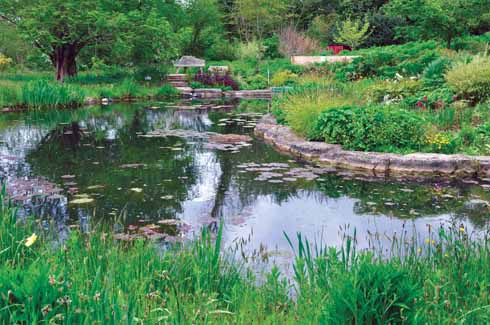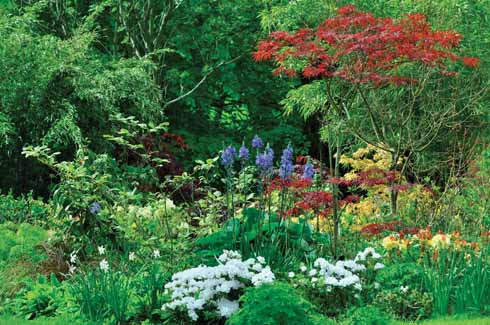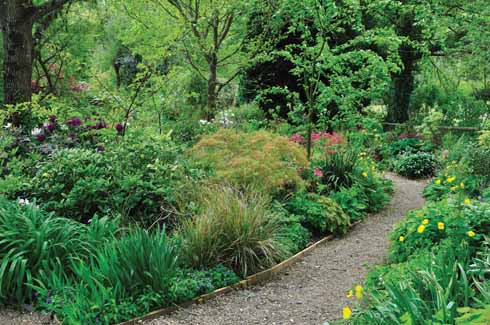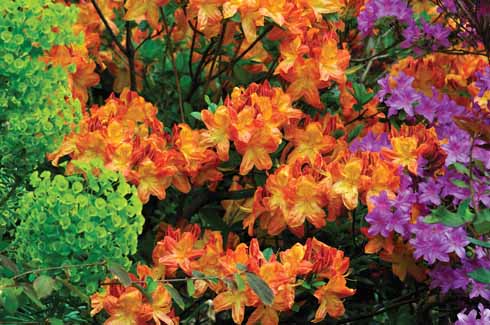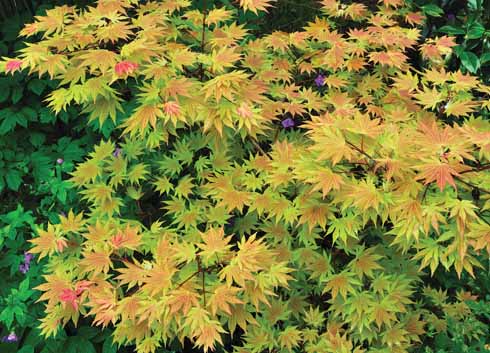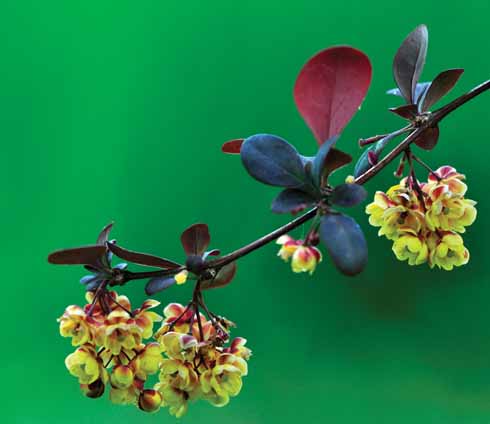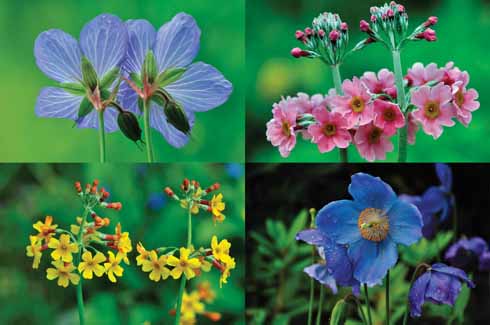Dorset Garden: Braddocks, Oxbridge
Chris Shaw and Colin Varndell visit a garden that just goes on and on
Published in March ’14
Three acres of plant-packed sloping gardens, reads the description, but Braddocks is a garden that cannot possibly be reduced to half a dozen words. Tucked away in a fold of hills just south of Melplash, this is a feast for the eyes that goes on and on.
Doctor and Mrs Roger Newton have lived in Oxbridge since 2004, but with major works to be undertaken on the house and the hard landscaping surrounding, the garden that now exists didn’t begin to take shape until spring 2006. It was a stroke of great fortune that in the 1960s the owner planted some magnificent trees. Two twisted walnut trees of impressive girth and spread are even older than that. The trees have matured to provide a high canopy that is ideal shelter for some of the more spectacular of the larger spring shrubs, as well as providing focal points around which paths weave through the packed beds and borders.
Dr Newton was obviously more than happy to be faced with three acres in which he could, to sum it up neatly, get in and get planting. ‘You will see as you go round,’ he said, ‘that I love rhododendrons and primulas in particular.’ He added that having recently retired, he now spends all his time in the garden, which he manages single-handedly. Mrs Newton agreed that her husband was the gardener, taking no part herself but obviously enjoying a hobby which provides such a beautiful and ever-changing landscape.
Looking forward to losing myself among what I could already see were enticing bursts of colour, I first stopped to admire two beautiful paeonies in full bloom on the terrace, one dusky pink and one lemon. It was the fact that they were in flower that surprised me. Spring had been – and still was – unseasonably cold and yet here in what Dr Newton described as a frost pocket the plants were so much further advanced than in other parts of Dorset. The trees obviously provide enough shelter to lift the temperature just those vital few degrees.
Beneath a lovely oak and equally impressive goat willow I found the first rhododendrons in bloom. These had been grown from seed, said Dr Newton, but thanks to an Irish wolfhound who liked chewing up plant labels, most had to flower before they could be identified! The shrubs are now about ten years old and their vibrant flowers light up the woodland. There were some wonderful colour combinations here, with mid-green and yellow acers, a purple azalea and striking orange rhododendron all fronted by lime euphorbias.
The first of many magnificent magnolias was in full bloom, the flowers showing no sign of frost damage. Tree ferns in pots were placed to fill in the gaps; not that I could see any gaps as the underplanting of day lilies, hellebores, acanthus and epimediums was doing an excellent job of ground cover. A splash of peachy heuchera was surrounded by vivid yellow poppies and a striking pinky-red acer. Acer davidii ‘George Forrest’ was placed where it could be enjoyed from a seat looking down towards the lily pond, the sound of water trickling over a small cascade between banks of astilbe, alchemilla and hostas. The beauty of this acer is in the trunk as much as the foliage; not for nothing is it known as the snake bark maple. Gunnera was just raising its giant leaves and a handful of roses didn’t look at all out of place. Tulips and iris provided early colour, with plenty of clumps of perennials such as asters already filling in for summer.
The hostas were worth a second look, as I could hear visitors marvelling at the size of the clumps as well as their slug-free leaves. ‘Nematodes are the way to go!’ I heard one lady announce. The hostas, as well as everything else, seemed to be of giant stock. There are four large compost bins in the garden, the contents of which are used to enrich the soil. This has been a much disturbed area over time and is now mainly loam over heavy clay. Dr Newton is a firm believer in studying an area for a couple of seasons before embarking on the final planting. As for those slugs, in a garden the size of Braddocks reliance is placed on keeping the surrounding ground as clear as possible and being pro-active with pellets early in the season.
The two large ponds are edged and separated by tall clumps of bamboo, dogwoods and feathery pampas grass. The new green of ferns surround a pretty Magnolia stellata. Candelabra primulas in delicious shades of deep to light pink rub shoulders with bluebells. The smaller of the ponds lies beneath a magnificent redwood, where a seat and table invite you to stop and enjoy the views. Even further down this apparently never-ending garden more camellias, rhododendrons and azaleas delight the eye.
Acers, no matter what colour their foliage, always earn their place. Acer palmatum ‘Deshojo’ delights with its shrimp-coloured spring foliage and I loved the bi-colour effect of the green leaves edged with burgundy of Acer palmatum ‘Kiyohime’, a more compact form if you’re short on space. There are plenty of viburnums, another large family, and hydrangeas were just pushing out new shoots beneath last year’s papery flowers. Mown paths lead between wild flower areas and yellow tree paeonies were a picture against the blue spikes of camassia. This tough bulb is ideal for naturalising and is not fussy about soil conditions.
I stopped to touch the bark of a small cherry, Prunus serrula. It’s irresistible, the polished mahogany colour gently peeling as the tree grows. Magnolia ‘Gold Star’ caught my eye, the stellata-type pale lemon flowers being more frost-tolerant than some. This was outclassed, I thought, by Magnolia denudata ‘Yellow River’ with its deeper lemon flowers, goblet-shaped and with a lovely perfume. Both, however, were immediately ousted from top spot by Magnolia ‘Daphne’, its huge cup-shaped flowers of butter yellow mouth-wateringly beautiful.
Nearer the house the grass was more extensive and more manicured. A new alpine bed had been planted up with heathers and gentians, alliums and campanulas. Two raised alpine beds were also under construction further down the sloping grounds but, as a notice advised, the weather had impeded progress. There were other signs posted, too; colour photographs of mid-summer borders which whetted the appetite for a further visit. Wispy grasses caught my eye, perfect foil for a vivid orange geum nearby; the dainty layers of Cornus alternifolia ‘Argentia’;
a group of Rosa ‘Wild Edric’ against deep-hued berberis.
What a joy to have the space for it all, I thought – then imagined the work involved. Despite this, there had still been time to espalier ‘Adam’s Pearmain’ apples into a pink-blossomed balustrade for a path. A large bed of roses close to the terrace had three clematis soaring in the centre. I picked out hamamelis, dicentra – the list seemed endless.
This was the first time Braddocks had opened under the National Gardens Scheme, with open days also planned for later in the season. Private visits are possible by appointment (01308 488441) but do check the Yellow Book (or visit www.ngs.org.uk) to ensure the owners are happy to greet visitors again. Dr Newton would be more than justified in saying that he was too busy, but I suspect he is as happy to share this spectacular garden as I was to spend two hours among his handiwork. ◗
